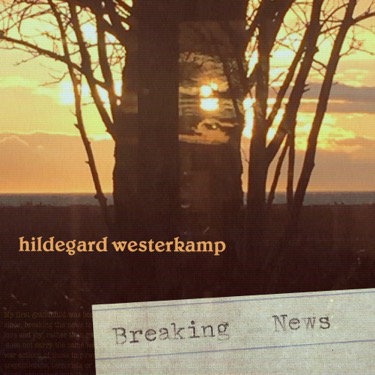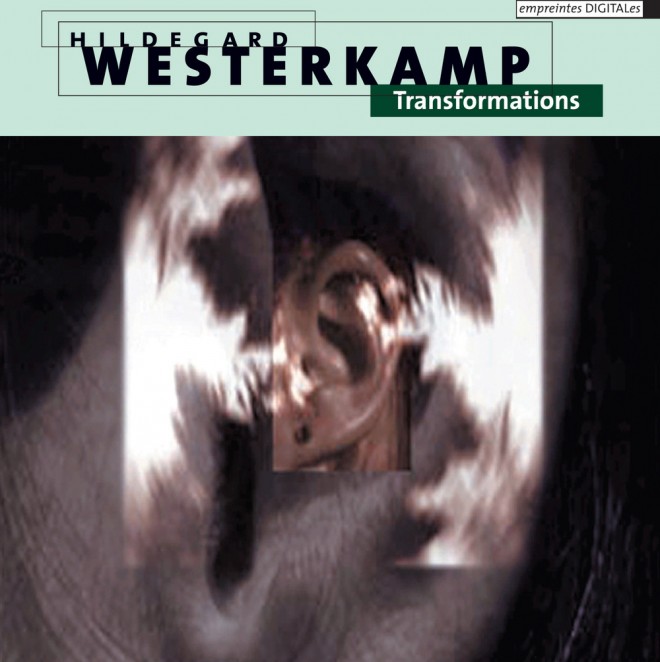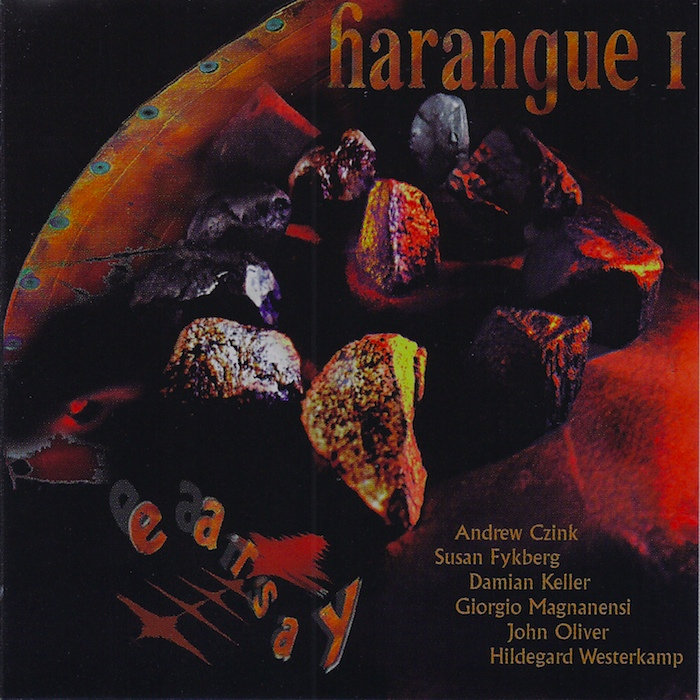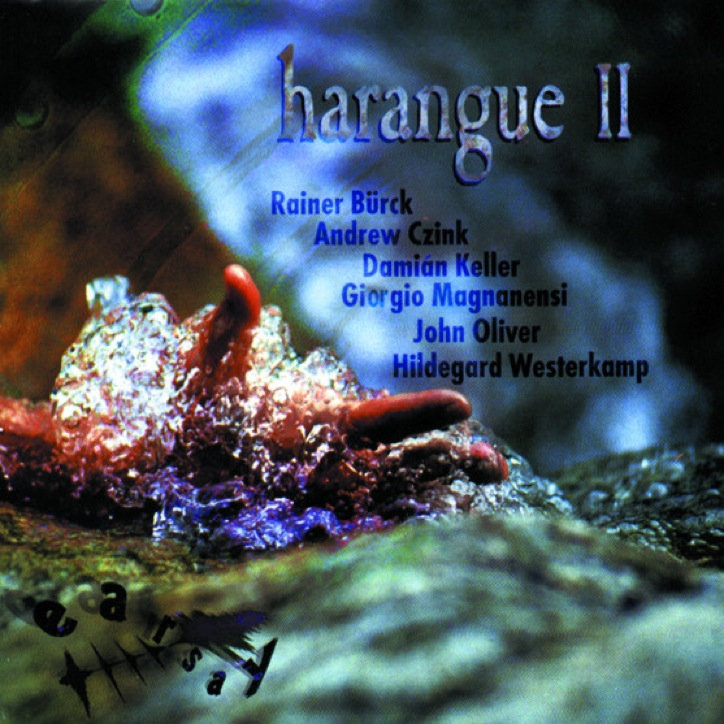Reviews and comments
Reviews of Recordings
“Breaking News invites the listener to surrender to a journey to the place and time of the recording, transitioning into an abstraction of the original sounds, guided by her studio practice with looping, filtering, equalising, resonating, reverberating. It brings all the technique, sound research and creative thinking of a career spanning half a century into the present moment where for Westerkamp, headphones are still for listening, not fashion.”
The Wire 460, p. 45 (excerpt)
“…audio pieces as vivid as any cinematic or literary work.”
– Musicworks #142
"Today, listening to this, I believe I was listening to something as good and as profound as anything by Cage or Stockhausen and this needs to be placed alongside the greatest composers of all time as a triumph of humanity."
birdboyblizzard.music.blog/2022/03/28/breaking-news-by-hildegard-westerkamp/

FOUR EXCEPTIONAL WOMEN
For this CDe Xpress #1, our focus is exceptional women. The compacts discs are by Pauline Oliveros, Laurie Spiegel, Eliane Radigue, and Hildegard Westerkamp......
.......Hildegard Westerkamp's compositions typically reflect our acoustic environment, including its urban and wilderness soundscapes, the voices of passersby, of children, of traffic and industry, and the sounds of various cultures. As in the music on this compact disc, she often includes texts, sometimes by Canadian poet Norbert Ruebsaat, sometimes her own. This CD is an exceptional compilation of her soundscapes. 'A Walk through the City' (1981), based on Ruebsaat's poem, is a tour through Vancouver's skid row, with its traffic sounds, voices, and other sounds turned into an evocative dreamlike audio panorama. In 'Fantasie for Horns II' (1979), electronic sounds derived from foghorns, trainhorns, and boathorns accompany a solo French horn. 'Kits Beach Soundwalk' (1989) is a narrative soundscape walk through Kitsilano beach in Vancouver. 'Cricket Voice' (1987), as Westerkamp describes it, "is a musical exploration of a cricket, whose song I recorded in the stillness of a Mexican desert region called the Zone of Silence ..." And 'Beneath the Forest Floor ' (1992) was composed from sounds recorded in old-growth forests on British Columbia's west coast. Westerkamp says it well: "I compose with any sound that the environment offers to the microphone, just as a writer works with all the words that a language provides ... I like to use the microphone the way photographers often use the camera ... "
– CD eXpress #1, March 10, 98
CDeMusic.org (no longer active)
The pieces on this CD provide a powerful retrospective of Westerkamp's work with environmental sound sources. And it is 'work' that we hear: these are not unadulterated soundscapes -pristine aural documents of time and place - but carefully wrought sonic forms in which the composer performs a subtle non-invasive surgery on our listening. Sometimes her intervention is more overt; as in "Kits Beach Soundwalk" where her speaking voice becomes the guide that leads us through a transforming world, suggesting her own sonic dreamscapes and depicting them in sounds along the way. Here we travel together through the shimmering chatter of barnacles to birds, beeps, watery tricklings and even a ghostly thread of Mozart before the low-pitched "monster" of the city returns. This is perhaps the most didactic journey on the CD, but in the most forgiving and imaginative sense of that word.
Another piece, "A Walk through the City" also includes speech, but this time as a poem spoken by its author, Norbert Ruebsaat. His voice, sometimes confined in short-wave radio timbres, sometimes real and reciting, sometimes whispering in the listener's ear, is the central all-knowing presence in this tale of urban sounds. Westerkamp did not record all the original sounds herself (many are from the World Soundscape Project's admirable collection) and it sometimes shows in some obviously 'archival' recording perspectives. But perhaps this kind of distancing is appropriate in a piece which veers from personal to impersonal, taking the listener on a swooping flight above the real city, where layered children's voices, reminiscent of "Gesang der J?glinge" or evocative mouth-organ strains, emerge unexpectedly from evolving traffic sounds and sliding drones and glissandi. The closing gesture, three separated descents - a tough and final punctuation - is inspired, while the use of spoken poetry in conjunction with such a rich sonic world makes for challenging and ultimately rewarding listening. This is a piece that asks, and deserves, to be heard again and again.
An earlier piece "Fantasie for Horns II", dating from 1979, is for live horns (Brian G'Froerer) and tape; the tape using the sounds of other horns: cars, trains and whistles. An harmonic world characterized by slow drones and filtered timbres becomes the background for a surprisingly Mahlerian horn part. "Cricket Voice" begins with looped rhythmic patterns that are almost minimalist in character, but soon the layered sounds, derived from the cricket's call, weave a peculiarly tactile fabric. This is a composer who loves beautifully sculpted timbres, often focussing on high frequency and carefully 'hand-tinted' spectra, or using low and high pitched sounds in an almost metaphorical sense. Many of the sounds have the clear, crisp hyper-reality of the acousmatic world, but Westerkamp has different stories to tell. The final piece on the CD, "Beneath the Forest Floor" is the most recent, dating from 1992. This forest grows from a low-pitched rhythmic drone and blooms as a primeval world in which birds cross the densely populated space suddenly and without warning. In the other pieces Westerkamp seems, to me at least, present and accompanying the listener: her words, or her musical processes, travel with us. Here, I felt comfortably lost - abandoned in an only occasionally familiar world which rose into an ecstatic sunlit reiteration of piping tones, birdsong and watery oscillations. Just when kitsch-ness was on the cards the music shifted a gear upwards and became a more abstract, transcendent encounter. Reading the liner notes I see this work is, for Westerkamp, about peace and the 'inner forest' in each listener. As with all the pieces here, she suggests a signposted listening path. But one gets the feeling that it's fine to walk around in the woods awhile.
– Spring 99 ARRAY issue on ICMA website / Reviewed by Katharine Norman
computermusic.org
click on: Back Issues Array Online - Spring 1999 / click on: CD Reviews
"Transformations" on Empreintes Digitales. ED is a great label of enterprising experiments in psycho-electrical-acoustic works. Amazing stuff they put out including Francis Dhomont, Claude Schreyer, H. Westerkamp and many others. The odd thing is, is why Canada is so in the forefront of electro-acoustic work? Soundscape philosophy as well? Most of this stuff is of extremely marginal value in the USA but in Canada it seems to be part of the dialectic. In the forefront of confronting our natural ambience and how technology and humans have impact on this is HW. She developed her soundwalks in the 80s which entailed a kind aural equivalent of the Situationists Dérive. "A Walk" is a sonic dérive. A sojourn through Vancouver's skid row including the usual urban din. These sounds are presented as is but also as sound objects that were manipulated in the studio. What Westerkamp does superbly is encourage us to invest in deep listening as a way of setting soul and environment in some kind of cognizance balance.
– wReck thiS meSS on Radio Patapoe 97.2 - Amsterdam
Reviewed by Bart Plantenga

HARANGUE I - compilation (CD on Earsay Productions) Yes, I'm also a little dabbling in the so called 'world music' in search for music that affects me or sounds interesting to me for some reason. I just like music and so it is a pleasure to discover what kinds of music have been developed within different cultural contexts. Why should I limit myself to western music? Mostly the term 'world music' refers to traditional forms of music. Music that reflects and expresses a specific cultural identity. What has this introduction to do with the cd 'Harangue 1'? Well contributors to this cd come from very different parts of the world: Canada (Hildegard Westerkamp), Argentina (Damian Keller, who likes to listen to tango), New Zealand (Susan Frykberg), Italy (Giorgio Magnanensi), Canada (Andrew Czink & John Oliver). So it came to my mind if it makes any sense to think of 'world music' when we consider electroacustic music. Is electro-acustic music product of one (western) culture or is electroacustic music - the way it is produced - more of a musical instrument that can be used within different cultural contexts. Is there a typical european, american of latin-american kind of electro-acustic music? I don't know. Or is electro-acustic music a sort of meta-cultural platform where influences of different cultures are at work?
To end this series of questions I must say that I like the piece by Hildegard Westerkamp most. It is a piece where environmental sounds (lots of rain: nature not culture!) are transformed and manipulated into a very enjoyable piece. It reminded me of the films of Tarkovsky, who made a very careful use of sound and music in his films. Rain plays here a big role. Westerkamp and the other contributors were more or less unknown to me. Czink and Oliver are also both co-director of Earsay Productions. "The label showcases composers whose work shares a concern for rich, carefully crafted sound and a gutsy, intense sensibility. The music ranges from pure acoustic to the sonic explorations of electroacoustics and soundscape works." Most pieces on this cd are intense and dramatic. Few dull moments. All by all a very diverse overview of current electro-acustic music (DM).
Earsay productions website.
– From Vital e-zine in the Netherlands, Week 45 Number 199
...Hildegard Westerkamp's "Talking Rain" uses snippets of recorded rainfall, using them to build melodies, percussion patterns and intricate textures -- it's perhaps the most intriguing work on the disc...
– Excerpted from review by
George Zahora in SPLENDID E-ZINE...week of April 20, 1998
Talking Rain rather rescues this disc from the mostly mediocre content elsewhere. Ms. Westerkamp's rain is animated and evocative, peaceful and ominous, cold and warm. It is harmonized in places by other sounds from nature, like birds, but intruded upon by those from the city, like cars, the human voice, and footsteps. Processing is relatively modest in much of the piece, the composer allowing nature to tell its story. When the processing becomes dominant, it is quite often in the mimicking or exaggeration of the sound of rain itself. Try the passage beginning around 7:34, where the droplets become rapid and high-pitched, scurrying about to a background of slower droplets seeming to strike hollow wood or metal. A downpour ensues amid busy sounds from trucks and cars, all to wonderful effect. This 17-minute-plus piece is by far the longest and, more importantly, most rewarding work here. In addition, the composer's notes about the rain sounds (from the west coast of British Columbia) and about the work in general are most informative.
– Excerpted from the Computer Music Journal,
summer 1999, review of Harangue 1 Reviewed By Robert Cummings
I was familiar with Hildegard Westerkamp's lovely "Talking Rain" from its appearance on the Musicworks 72 CD. This familiarity made me appreciate the quality of the Dolby sound system even more than with the other works. Sounds that had before been arrayed in a stereo space were now moving about in planes of space, things had a real volume, and the recording of trucks on a rainy highway, about halfway through the piece, were positively awesome. In this piece, I saw that we had finally reached that state Varese was looking for where volumes and planes of sound could move through space.
– Excerpted from Leonardo Music Journal Review of immersion
- melbourne - 7 june - 14 june 1999 reviewed by Warren Burt
Complete list of compositions on harangue I:
1. shadeless, peopled/ Andrew Czink
2. Astonishing Sense... / Susan Frykberg
3. To Lions Gate / Damian Keller
4. Talking Rain / Hildegard Westerkamp
5. Copper Flying /John Oliver

...The always exceptional Hildegard Westerkamp paints a sonic picture of Delhi from ambient noise and shimmering synthesized notes, juxtaposing unearthly beauty with earthy reality...
Harangue II - Earsay Productions (CD)
Earsay productions website
full review of Harangue II
Complete list of compositions on harangue II:
1. STRINGendo / Rainer Bürck
2. Gently Penetrating... / Hildegard Westerkamp
3. scintilla / John Oliver
4. "...soretes de punta" / Damian Keller
5. Devour /Andrew Czink
6. MU / Giorgio Magnanensi & Andrew Czink

Press clips
"There was more than just a hint of oracular mysticism in Westerkamp's art. There was a magic in those sounds. It came from our sense of mingled delight and astonishment that such delicacy goes on under our very, very sophisticated noses. Fascinating and absorbing."
Stephen Pedersen, Chronicle-Herald, Halifax
"A magical fusion of sounds."
Globe & Mail, Toronto
"Westerkamp's tape works - which draw on sounds from the environment - are elegantly shaped, often witty, always eloquent. They register not just as created soundworks but as a way of listening to the world - the aural equivalent of a point-of-view."
Susan Mertens, Vancouver Sun
"This composition is as expansive as the desert, intimate as the voice of a single cricket."
Andra McCartney, Musicworks, Toronto(about CricketVoice)
"Westerkamp creates new possibilities for listening. One can journey with her sound to inner landscapes and find unexplored openings in our sound souls. The experience of her music vibrates the potential for change. Her compositions invite interaction - a chance to awaken to one's own creativity. One can transform through listening as she has. In the music and soundscapes of Westerkamp we feel memory and imagination as we hear through to the future."
Pauline Oliveros,Kingston, N.Y., USA (about CD transformations)
"Westerkamp's music balances a poetics of sound with social commitments that include feminism and environmental politics. Her compositions are critical enactments of acoustic space....All invoke attentive listening."
Donna Zapf, Beiträge zur Neuen Music, Germany
"École Polytechniquetaps into ancient lamenting traditions, with their cathartic and healing functions that historically served both the individual and the community....I am shaken by its evocation of violence....and impressed by the way Westerkamp avoids the traps of literalism or melodrama."
Tamara Bernstein, Herizons
"An evocative score in any context, École Polytechnique seemed to speak with special poignancy to the Montreallers who witnessed its premiere. In a sense, it spoke for them."
Wilhelm Littler, Toronto Star
"Mere words are inadequate to describe what took place when the symphony began....Waves of sound rolled back and forth across the harbour bringing thousands of downtown office workers to their windows. The Canada geese from Stanley Park were aroused and circled through the boats, honking loudly as they joined in."
Ken Drushka, Harbour and Shipping) about the Harbour Symphony)
"The sound was like that of a herd of happy elephants caught in a traffic jam."
Globe & Mail, Toronto (about the Harbour Symphony)